Splash Page

Above is the splash page for Pathways. This is the page that users who are not logged in are redirected to at the root URL. For each page, we use a consistent header with the pathways logo on the left, and the NHS and GSTT logos on the right. This provides the user with a sense of trust that they are using an application which is associated with these reputable organisations.
Medical Professional Facing
Medical Professional Hub
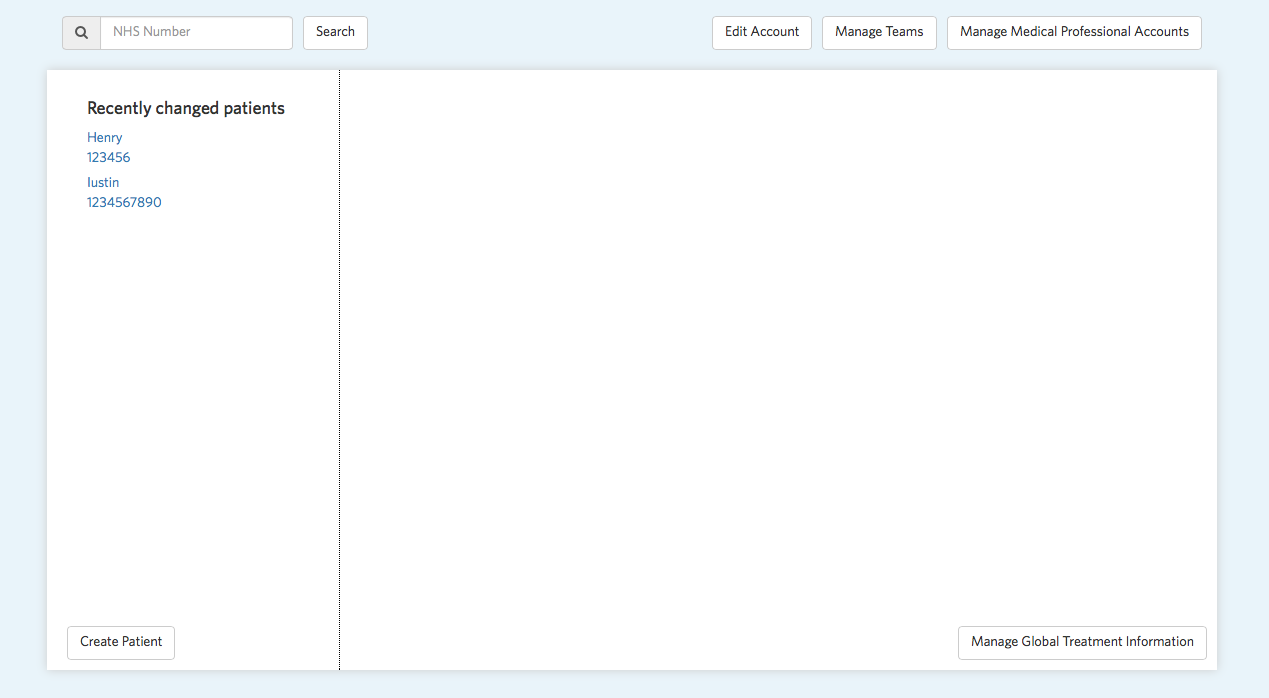
This is the medical professional hub - the first page a medical professional would see upon logging in. From here, a medical professional can administrate over patients within their teams. The list view on the left shows the most recently edited patients, and the detail view on the right displays the currently available information to the selected patient. In the screenshot above, no patient has been selected. On the bar above the hub card, there is a search option to find a patient by their NHS number. If the currently logged in medical professional is a superuser, they have the option to administrate over all patients and edit the globally available information for all patients.
Create Patient
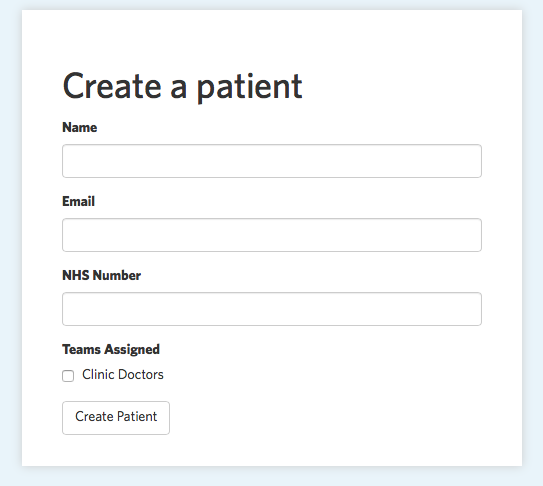
This is the view for a medical professional to create a patient. They have the option of assigning this patient to any teams for which the medical professional is already a member. Upon creation, the patient is assigned a random password and can login with this and their NHS number.
Edit State
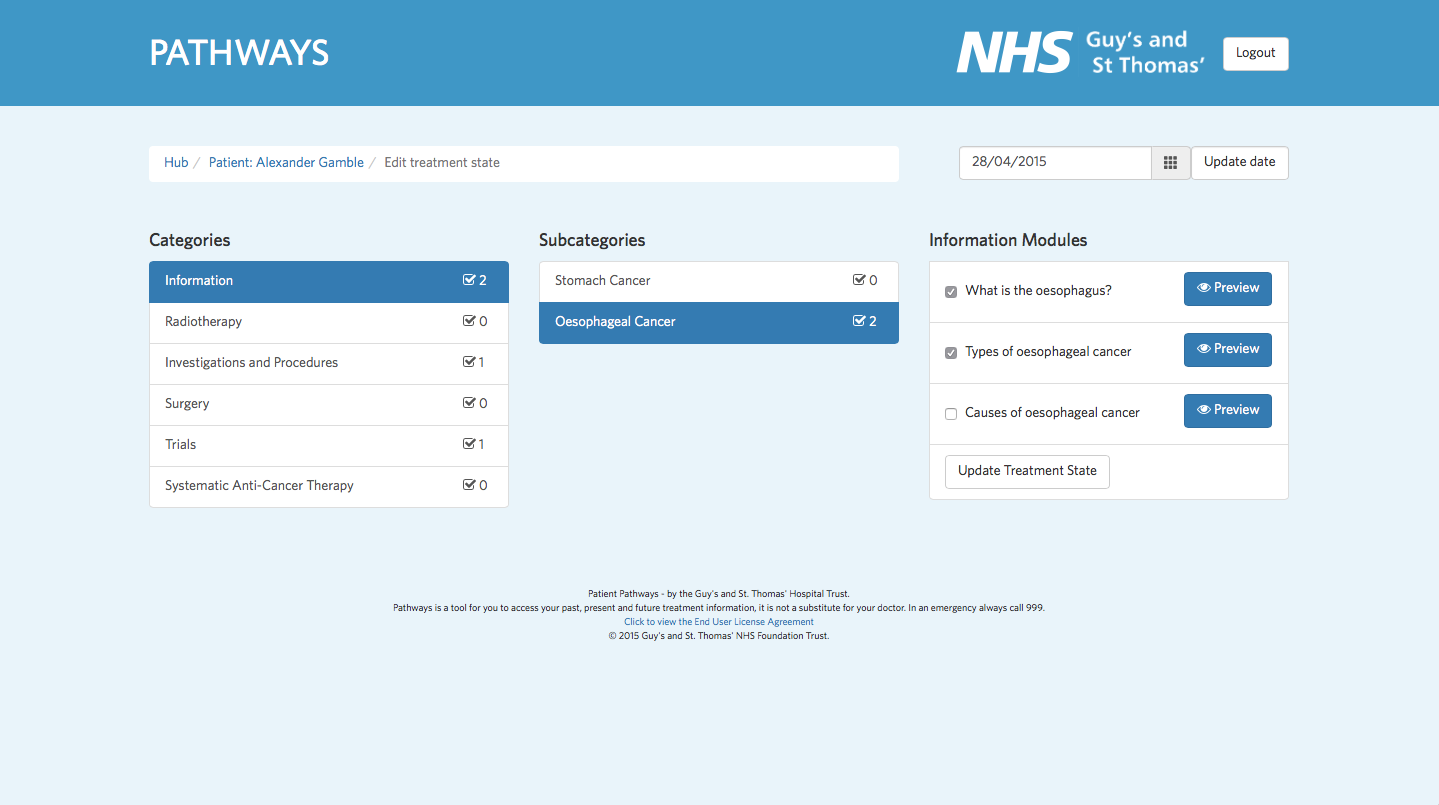
This is the view where a medical professional can edit the information given to a patient which is associated with a specific date. Categories are shown on the far left, subcategories in the middle, and the individual pieces of information on the far right. Within this view, medical professionals can preview the information they assigning and update the date it is associated with. As an additional feature requested by our client, we provide a confirmation box for the medical professional to verify the changes they have requested.
Edit Modules
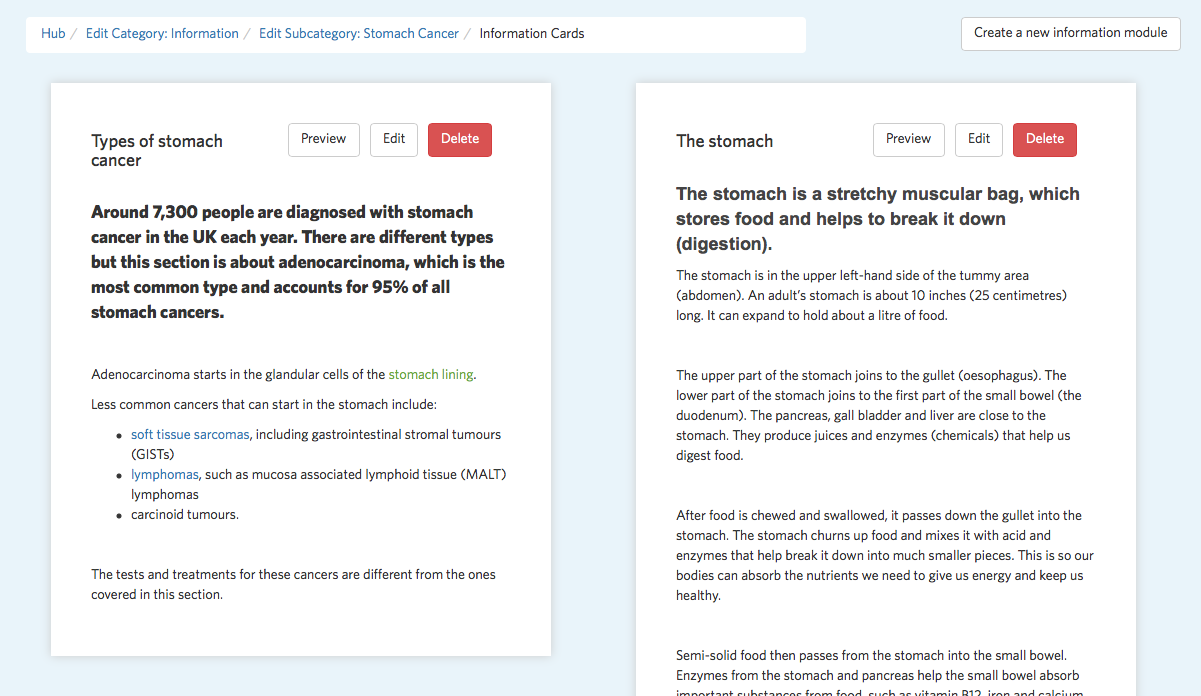
This is the view where a superuser can administer the globally available treatment information accessible by patients. They have the option to create, edit, preview and delete pieces of information.
Edit Information
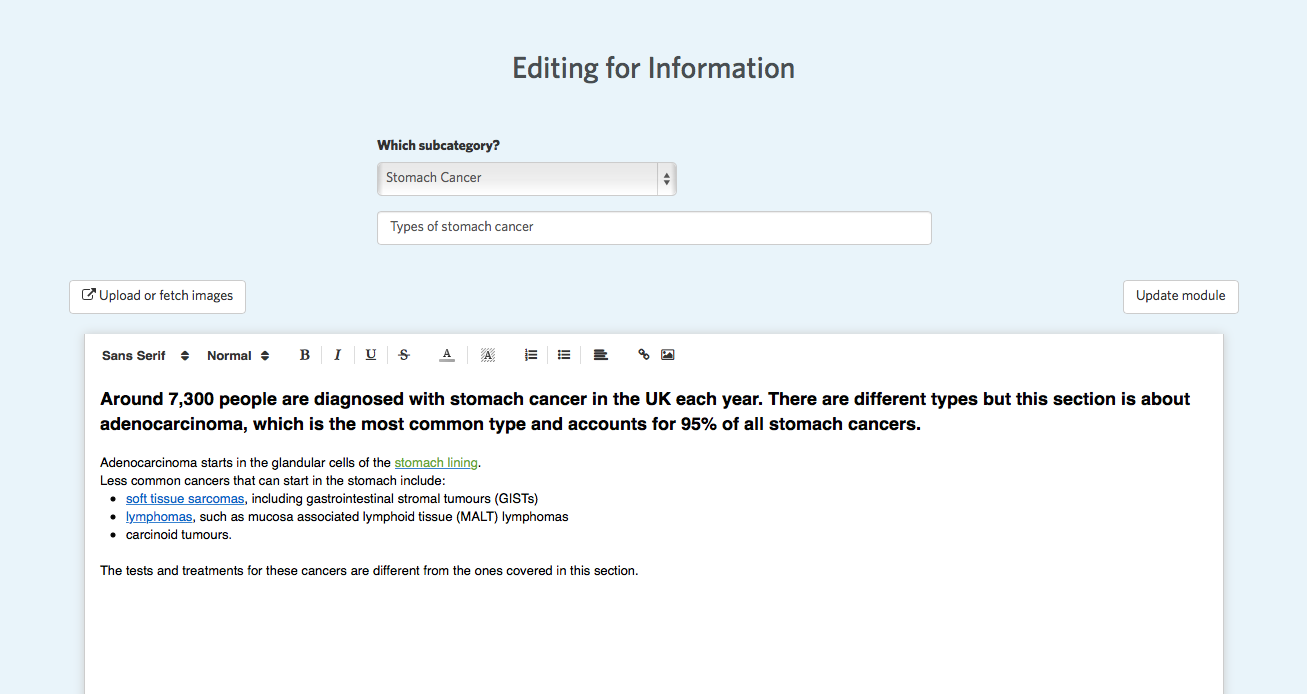
This is the view for editing the global treatment information. The medical professional can edit the subcategory the information is associated with, its title and the associated information. The application features a custom image uploader which can be used to embed images within the information. For the actual information, the page features a fully rich text editor.
Patient Facing
Patient Hub
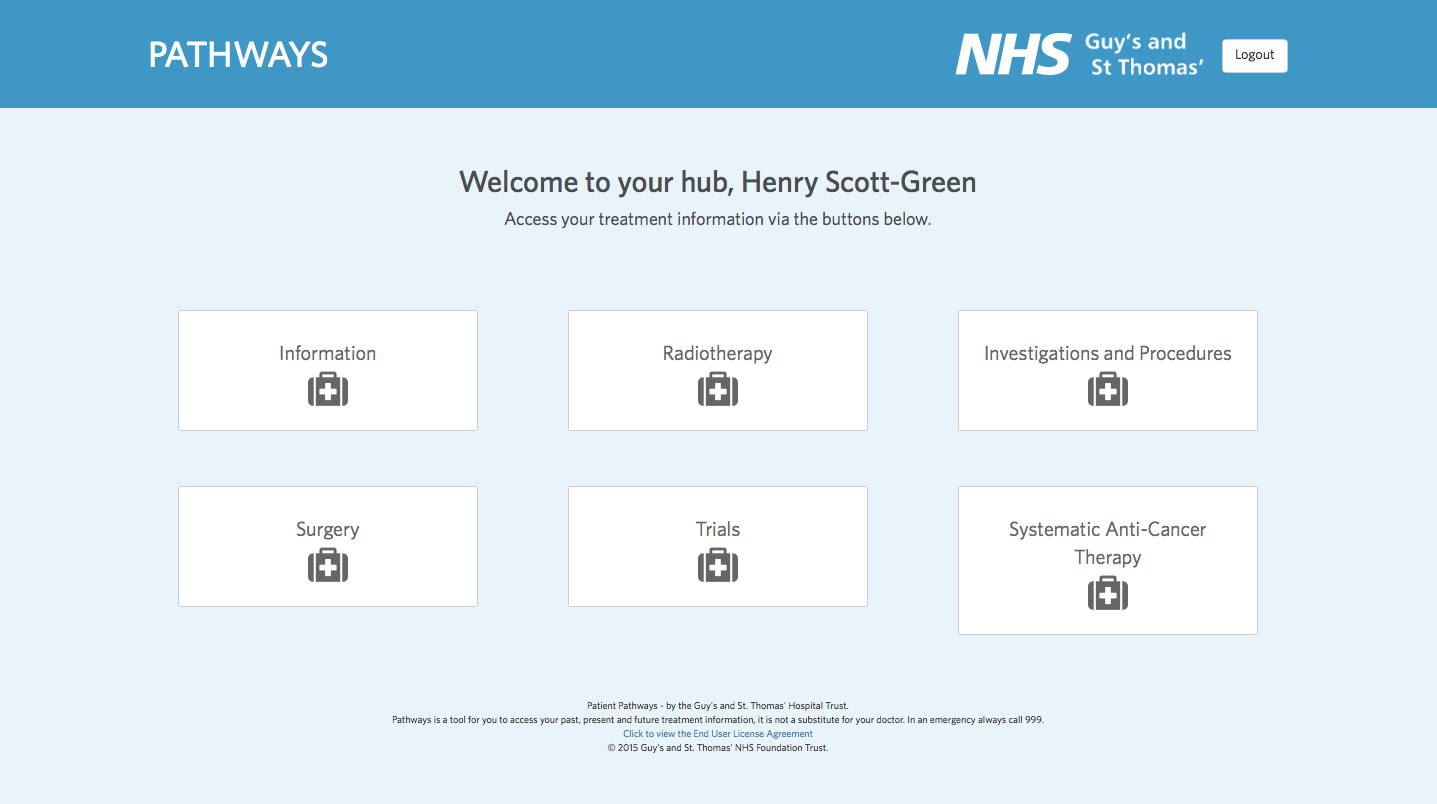
This is the patient hub - the page patients are redirected to after they have logged in. There is a welcome message for this patient and the different categories of information available to them are listed in a grid below this. Clicking one of these takes them to the timeline view for this category.
Patient Timeline
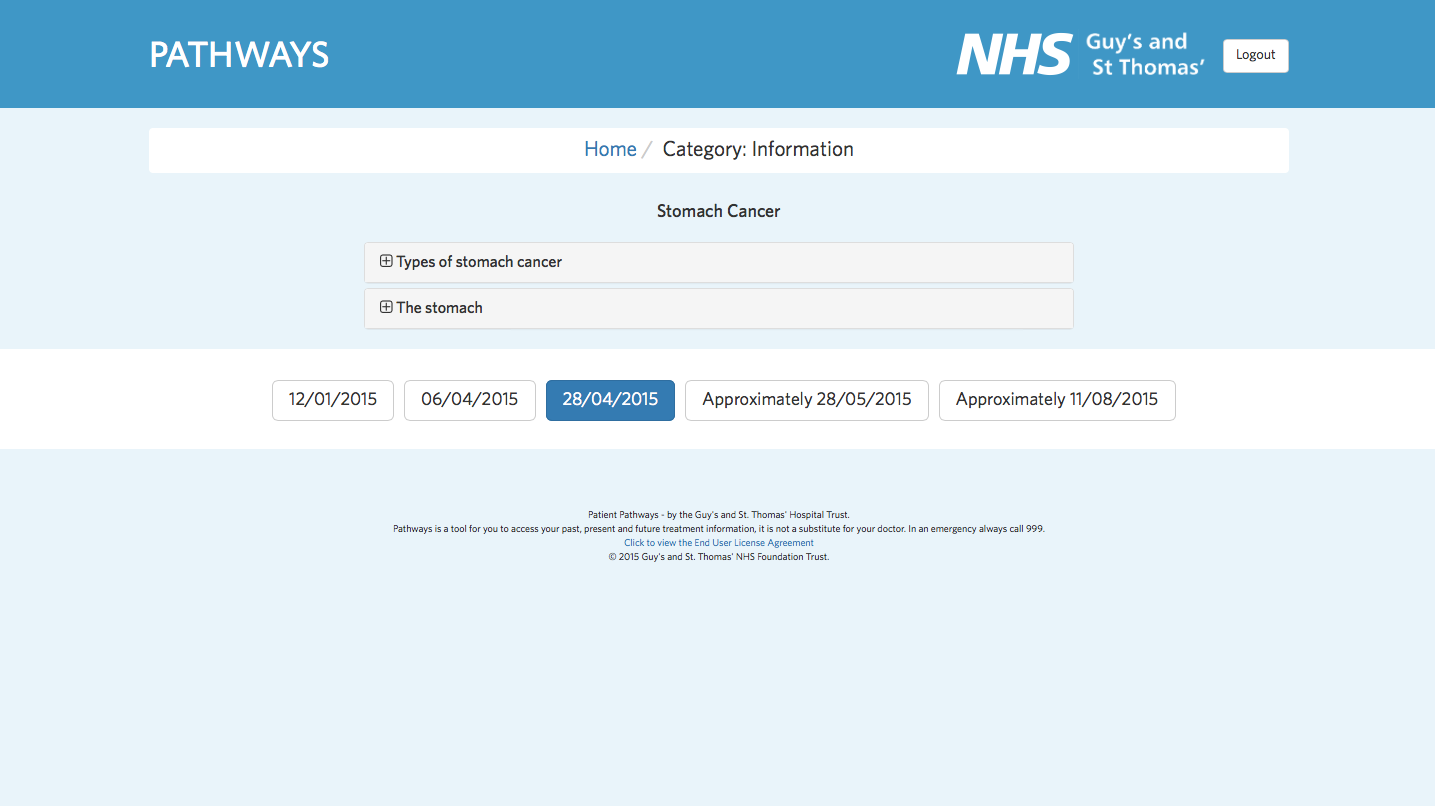
This is the timeline view for a specific category. Patients can see all information which will be relevant to them at different times. Within each of these dates listed on the bottom row, there will be a selection of subcategories and treatment modules listed. For dates in the future, the patient is told that these dates are approximate. All rich text formatting the medical professional has specified is preserved within this view. If the timeline overflows with more dates than is available in the screen real estate, the patient has the option to scroll along the timeline using the mouse or scroll bar that would be presented.
| # | Requirement |
|---|---|
| 1 | Pathways must include super user account functionality to manage doctor and patient account creation and administration. This account level is to be the only one able to delete patients, create doctors and to assign patients to alternate medical professionals. |
| 2 | Pathways must include medical professional account functionality with access to create and modify patient accounts, as well as to assign treatment modules to a patient. This account must not be able delete patient accounts. |
| 3 | Pathways must include functionality to allow medical professionals to assign information in the future, to show on a patient timeline in an alternate color as a possibility. |
| 4 | Pathways must include patient account functionality to view all treatment information assigned by medical professionals. |
| 5 | Pathways must include patient account functionality to permit navigation backwards and forwards through information previously assigned on a timeline. |
| 6 | Pathways must include comprehensive data security measures to ensure all patient data remains entirely confidential. |
| 7 | Pathways must include sufficient access controls to permit only registered doctors and registered patients accessing the system |
| 8 | Pathways must include a comprehensive data set of treatment information, symptom information and nutritional information that may be accessed by any patient. |
| 9 | Pathways must include functionality for a medical professional or super user to add, update or delete any and all information from the set of available treatment information modules. This must include the content and the title of the modules. |
| 10 | Pathways must work on any device a patient may own and not place a financial burden on any patient. |
| 11 | Pathways must feature responsive design to ensure the user interface is navigable from any device. |
| 12 | Pathways must feature functionality to reset the password of any patient. |
| 13 | Pathways must feature functionality to allow a patient who no longer wishes to be involved in the Pathways project to have their account deleted. |
| 14 | When information is updated in Pathways it must be immediately accessible to every patient. |
| 15 | Pathways must be scalable for a potential roll out to other hospitals and NHS trusts. |
| 16 | Pathways must feature a comprehensive team access and management system to show only relevant patients to each doctor and to protect accidental updates for incorrect patients. |
| 17 | Pathways must feature confirmation messages to ensure no information assignment is accidental. |
| 18 | Pathways must be completely secure and prevent any access to any user not registered in the system. |
| 19 | Pathways must include functionality to allow professionals to assign information to patients on dates in both the past and future. |
| 20 | Pathways must assist patients in the decision making process by providing them greater access to a great quantity of information than previously possible. |
| # | Req. | Achievement |
|---|---|---|
| A1 | RQ2 | Superuser account functionality implemented satisfying RQ1. |
| A2 | RQ2 | Medical professional account functionality implemented satisfying RQ2. |
| A3 | RQ3 | Post-dating information assigning has been implemented satisfying RQ3. |
| A4 | RQ4 | Patient account functionality has been implemented satisfying RQ4. |
| A5 | RQ5 | Timeline navigation functionality has been implemented using a timeline on the bottom of both the patient hub and treatment module pages. |
| A6 | RQ6 | Pathways is hosted on Microsoft Azure, recently certified compliant with NHS information security requirements. Pathways protects against SQL injection attacks through the rails framework and through avoidance of raw SQL queries. We protect against timing attacks using the devise gem. Pathways is protected against cross-site request forgery, implemented through rails. |
| A7 | RQ7 | The Devise Ruby gem has been utilized to provide access controls for all patient and medical professional restricted pages. |
| A8 | RQ8 | A full set of all data required has been provided by the clinical team and loaded into Pathways. |
| A9 | RQ9 | The set of information loaded into Pathways is completely dynamic and may be modified by any professional at any time and will be instantly pushed to every user. |
| A10 | RQ10 | Ruby on Rails was used to build a browser based application that will function fully on any device. When coupled with A11 this allows for Pathways to be fully operable on any tablet or phone. |
| A11 | RQ11 | Responsive design has been implemented throughout Pathways using the Bootstrap framework. |
| A12 | RQ12 | Patient passwords may be reset by any doctor with access to a patient, and all doctor password can be reset by any superuser. |
| A13 | RQ13 | Patients can be deleted at any time by any of their assigned doctors or by any superuser. |
| A14 | RQ14 | All data in Pathways updates instantly for every patient as soon as a professional presses save. |
| A15 | RQ15 | Pathways is fully scalable thanks to the use of cloud hosting, database indexing and team access management. These features allow the product to perform well with hundreds of users and to not overwhelm professionals thanks to team access levels. |
| A16 | RQ16 | Pathways features powerful team access controls, which show only patients assigned to each professional when they login. |
| A17 | RQ17 | Pathways features confirmation messages for every update to a patient treatment state. This ensures every access taken is deliberate and was implemented upon a request by the client. |
| A18 | RQ18 | Pathways utilizes the Devise Ruby on Rails gem to implement industry standard user access controls for both patients and medical professionals. |
| A19 | RQ19 | Pathways allows doctors to back-date and post-date information assignments to patient, which will be useful when explaining information to a patient that may be most relevant for future treatment. |
| A20 | RQ20 | By satisfying RQ1-19 Pathways assists patients in the decision making process by providing them greater access to personal treatment information than was previously possible. |